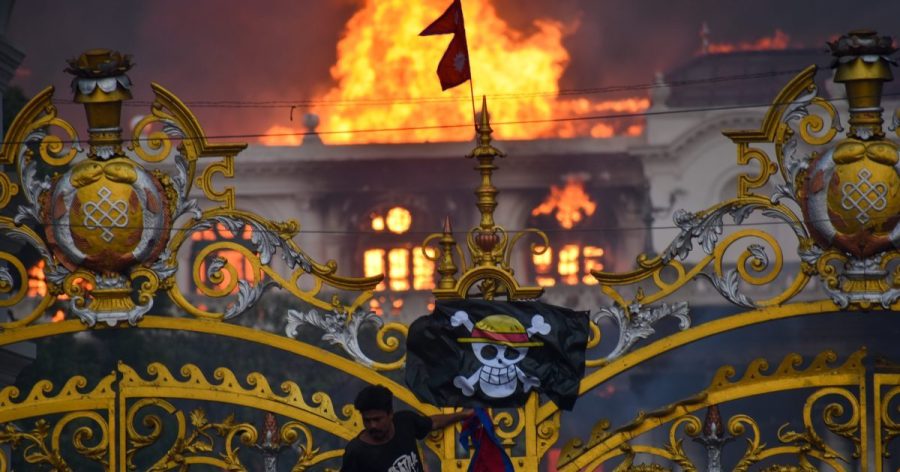The Conversation – From the streets of Paris and Rome to Jakarta, Indonesia, and New York, a striking banner has emerged in protest squares. The figure, with hollow cheeks, a broad grin, and a straw hat adorned with a red band, is instantly recognizable. This image has been raised by young demonstrators demanding change. In Kathmandu, Nepal, where public frustration with the government reached a boiling point in September 2025, the symbol became the defining emblem as flames spread through the gates of Singha Durbar, Nepal’s grand palace complex and seat of power.
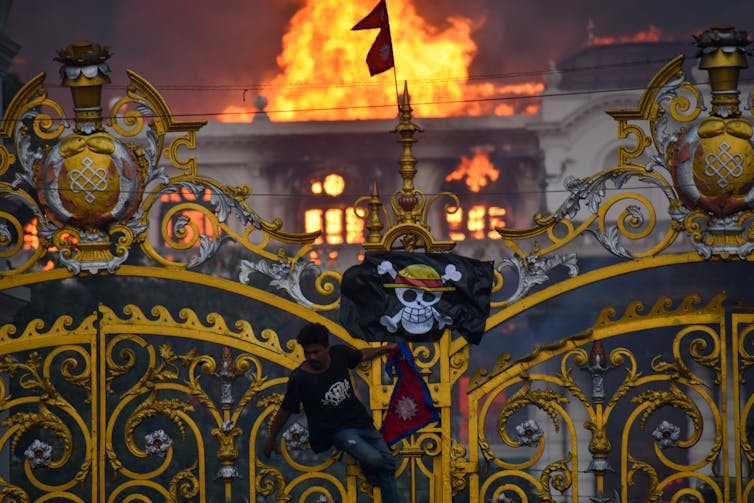
The image, often seen on a flag with a black background, originates from “One Piece,” a highly popular Japanese manga. What started as the emblem of a fictional pirate crew nearly three decades ago has now transformed into a potent symbol of youth-driven resistance. It has appeared in demonstrations across Indonesia, Nepal, the Philippines, and France.
As a scholar of media and democracy, I observe the spread of the Jolly Roger of the Straw Hats Pirates—from manga pages to protest squares—as an example of how Generation Z is redefining the cultural language of dissent.
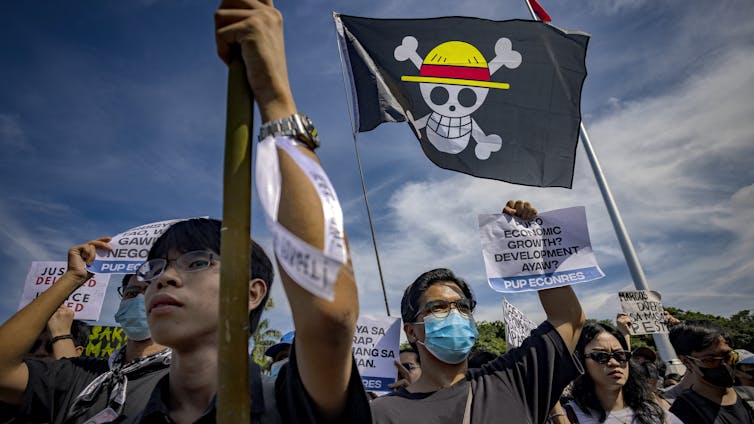
Pop culture as political expression
“One Piece” arrived at the birth of Gen-Z, created in 1997 by Japanese manga artist Eiichiro Oda.
Since then, it has sold more than 500 million copies and has a Guinness World Record for its publishing success.
It has spawned a long-running TV series, live-action films and a more-than-US$20 billion industry, with merchandise licensing alone generating about $720 million each year from Bandai Namco, the company best known for creating Pac-Man and Tekken.
At its core, “One Piece” follows Monkey D. Luffy and his crew, the Straw Hat Pirates, as they challenge a corrupt world government while seeking freedom and adventure.
For fans, the “One Piece” flag is not a casual decoration but an emblem of defiance and perseverance. Luffy’s ability to stretch beyond physical limits after consuming a magical fruit has become a powerful metaphor for resilience, while his unwavering quest for freedom against impossible odds resonates with young people navigating political environments marked by corruption, inequality and authoritarian excess.
When protesters adopt this flag, they are not simply importing an aesthetic from popular culture, but are drawing on a narrative already legible to millions.
The flag began cropping up in protests over the past few years. It was being waved at a “Free Palestine” protest in 2023 in Indonesia and in the same year in New York during a pro-Palestinian demonstration.
But it was in Indonesia in August 2025 that the flag’s political life truly took hold. There, protesters embraced it to voice frustration with government policies and mounting discontent over corruption and inequality. The timing coincided with government calls for patriotic displays during independence celebrations, sharpening the contrast between official nationalism and grassroots dissent.
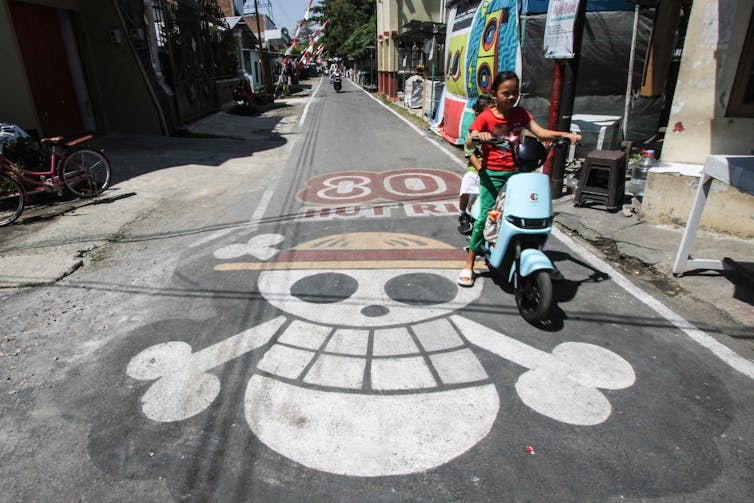
The movement gained momentum when authorities responded with strong criticism of the flag’s use, inadvertently drawing more attention to the symbol. Government officials characterized the displays as threats to national unity, while protesters viewed them as legitimate expressions of political frustration.
Why the flag travels
The speed with which the “One Piece” Jolly Roger flag spread across borders reflects the digital upbringing of Gen Z. This is the first cohort to grow up fully online, immersed in memes, anime and global entertainment franchises. Their political communication relies on what scholars call “networked publics” – communities that form and act through digital platforms rather than formal organizations.
Solidarity in this setting does not require party membership or ideology. Instead, it depends on shared cultural references. A meme, gesture or flag can instantly carry meaning across divides of language, religion or geography. This form of connection is built on recognizable cultural codes that allow young people to identify with each other even when their political systems differ.
Social media gives this solidarity reach and speed. Videos of Indonesians waving the flag were clipped and reshared on TikTok and Instagram, reaching audiences far beyond their original context. By the time the symbol appeared in Kathmandu, the Nepalese capital, in September, it already carried the aura of youthful defiance.
Crucially, this was not simple imitation. In Nepal, the flag was tied to anger at youth unemployment and at the ostentatious wealth of political dynasties displayed online. In Indonesia, it reflected disillusionment with patriotic rituals that felt hollow against a backdrop of corruption. In both cases, the Jolly Roger flag worked like open-source code – adaptable locally but instantly legible elsewhere.
Part of the flag’s effectiveness comes from its ambiguity. Unlike a party logo, the “One Piece” Jolly Roger flag originates in popular culture, which makes it difficult for governments to suppress without appearing authoritarian. During the latest protests in Indonesia, authorities confiscated banners and labeled them treasonous. But such crackdowns only amplified public frustration.
Fiction as reality
The “One Piece” flag is not alone in being reimagined as a symbol of resistance.
Across movements worldwide, pop culture and digital culture have become a potent resources for activists. In Chile and Beirut, demonstrators wore Joker masks as a visual shorthand for anger at corruption and inequality. In Thailand, demonstrators turned to “Hamtaro,” a children’s anime about a hamster, parodying its theme song and waving plush toys to lampoon political leaders.
This blending of politics, entertainment and personal identity reflects a hybrid media environment in which symbols drawn from fandom gain power. They are easy to recognize, adapt and defend against state repression.
Yet cultural resonance alone does not explain the appeal. The “One Piece” flag caught on because it captured real-life grievances. In Nepal, where youth unemployment exceeds 20% and migration for work is common, protesters paired the emblem with slogans such as “Gen Z won’t be silent” and “Our future is not for sale.”
In Indonesia, some protesters argued that the national flag was “too sacred” to be flown in a corrupt system, using the pirate banner as a statement of disillusionment.
The spread of the flag also reflects a broader shift in how protest ideas move across borders. In the past, what tended to travel were tactics such as sit-ins, marches or hunger strikes. Today, what circulates fastest are symbols, visual references from global culture that can be adapted to local struggles while remaining instantly recognizable elsewhere.
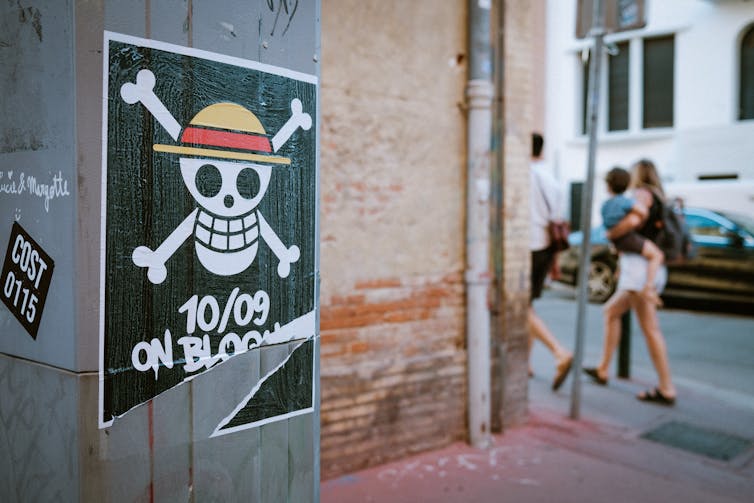
The flag goes global
The flag’s journey from Asian streets to protests in France and Slovakia demonstrates how the grammar of dissent has gone global.
For today’s young activists, culture and politics are inseparable. Digital nativity has produced a generation that communicates grievances through memes, symbols and cultural references that cross borders with ease.
When protesters in Jakarta, Kathmandu or Manila wave the “One Piece” Jolly Roger flag, they are not indulging in play-acting but transforming a cultural icon into a living emblem of defiance.
Copyright 2025 Nexstar Media, Inc. All rights reserved. This material may not be published, broadcast, rewritten, or redistributed.
For the latest news, weather, sports, and streaming video, head to MathHotels.com.
The Rise of a Cultural Symbol
The use of the “One Piece” logo in protests highlights how pop culture can influence political movements. Young activists are leveraging familiar imagery to express their frustrations and aspirations. This trend reflects a broader shift in how younger generations communicate and organize for change. By adopting symbols from entertainment, they create a sense of shared identity and solidarity among diverse groups.
Why “One Piece”?
The appeal of the “One Piece” character lies in its association with freedom, adventure, and rebellion. The Straw Hat Pirates represent a group of outcasts who challenge authority and fight for justice. These themes resonate deeply with young people who feel disillusioned with traditional institutions and seek alternative ways to voice their concerns.
Global Impact
The symbol has transcended its original context and gained international recognition. In various countries, it has become a visual shorthand for resistance against perceived injustices. Its widespread use suggests that the message of the pirates—of standing up for what is right—has universal appeal.
Media and Democracy
The integration of pop culture into political discourse raises important questions about the role of media in shaping public opinion. As more individuals turn to digital platforms for information and expression, the lines between entertainment and activism blur. This phenomenon underscores the need for critical engagement with media content and an understanding of its potential impact on society.
The Future of Dissent
The continued use of such symbols in protests indicates a growing trend toward creative and inclusive forms of activism. Younger generations are not only challenging the status quo but also redefining the tools and methods used to do so. This evolution in the language of dissent could have lasting implications for how societies address issues of inequality, governance, and human rights.

Pop culture as political expression
“One Piece” arrived at the birth of Gen-Z, created in 1997 by Japanese manga artist Eiichiro Oda.
Since then, it has sold more than 500 million copies and has a Guinness World Record for its publishing success.
It has spawned a long-running TV series, live-action films and a more-than-US$20 billion industry, with merchandise licensing alone generating about $720 million each year from Bandai Namco, the company best known for creating Pac-Man and Tekken.
At its core, “One Piece” follows Monkey D. Luffy and his crew, the Straw Hat Pirates, as they challenge a corrupt world government while seeking freedom and adventure.
For fans, the “One Piece” flag is not a casual decoration but an emblem of defiance and perseverance. Luffy’s ability to stretch beyond physical limits after consuming a magical fruit has become a powerful metaphor for resilience, while his unwavering quest for freedom against impossible odds resonates with young people navigating political environments marked by corruption, inequality and authoritarian excess.
When protesters adopt this flag, they are not simply importing an aesthetic from popular culture, but are drawing on a narrative already legible to millions.
The flag began cropping up in protests over the past few years. It was being waved at a “Free Palestine” protest in 2023 in Indonesia and in the same year in New York during a pro-Palestinian demonstration.
But it was in Indonesia in August 2025 that the flag’s political life truly took hold. There, protesters embraced it to voice frustration with government policies and mounting discontent over corruption and inequality. The timing coincided with government calls for patriotic displays during independence celebrations, sharpening the contrast between official nationalism and grassroots dissent.

The movement gained momentum when authorities responded with strong criticism of the flag’s use, inadvertently drawing more attention to the symbol. Government officials characterized the displays as threats to national unity, while protesters viewed them as legitimate expressions of political frustration.
Why the flag travels
The speed with which the “One Piece” Jolly Roger flag spread across borders reflects the digital upbringing of Gen Z. This is the first cohort to grow up fully online, immersed in memes, anime and global entertainment franchises. Their political communication relies on what scholars call “networked publics” – communities that form and act through digital platforms rather than formal organizations.
Solidarity in this setting does not require party membership or ideology. Instead, it depends on shared cultural references. A meme, gesture or flag can instantly carry meaning across divides of language, religion or geography. This form of connection is built on recognizable cultural codes that allow young people to identify with each other even when their political systems differ.
Social media gives this solidarity reach and speed. Videos of Indonesians waving the flag were clipped and reshared on TikTok and Instagram, reaching audiences far beyond their original context. By the time the symbol appeared in Kathmandu, the Nepalese capital, in September, it already carried the aura of youthful defiance.
Crucially, this was not simple imitation. In Nepal, the flag was tied to anger at youth unemployment and at the ostentatious wealth of political dynasties displayed online. In Indonesia, it reflected disillusionment with patriotic rituals that felt hollow against a backdrop of corruption. In both cases, the Jolly Roger flag worked like open-source code – adaptable locally but instantly legible elsewhere.
Part of the flag’s effectiveness comes from its ambiguity. Unlike a party logo, the “One Piece” Jolly Roger flag originates in popular culture, which makes it difficult for governments to suppress without appearing authoritarian. During the latest protests in Indonesia, authorities confiscated banners and labeled them treasonous. But such crackdowns only amplified public frustration.
Fiction as reality
The “One Piece” flag is not alone in being reimagined as a symbol of resistance.
Across movements worldwide, pop culture and digital culture have become a potent resources for activists. In Chile and Beirut, demonstrators wore Joker masks as a visual shorthand for anger at corruption and inequality. In Thailand, demonstrators turned to “Hamtaro,” a children’s anime about a hamster, parodying its theme song and waving plush toys to lampoon political leaders.
This blending of politics, entertainment and personal identity reflects a hybrid media environment in which symbols drawn from fandom gain power. They are easy to recognize, adapt and defend against state repression.
Yet cultural resonance alone does not explain the appeal. The “One Piece” flag caught on because it captured real-life grievances. In Nepal, where youth unemployment exceeds 20% and migration for work is common, protesters paired the emblem with slogans such as “Gen Z won’t be silent” and “Our future is not for sale.”
In Indonesia, some protesters argued that the national flag was “too sacred” to be flown in a corrupt system, using the pirate banner as a statement of disillusionment.
The spread of the flag also reflects a broader shift in how protest ideas move across borders. In the past, what tended to travel were tactics such as sit-ins, marches or hunger strikes. Today, what circulates fastest are symbols, visual references from global culture that can be adapted to local struggles while remaining instantly recognizable elsewhere.

The flag goes global
The flag’s journey from Asian streets to protests in France and Slovakia demonstrates how the grammar of dissent has gone global.
For today’s young activists, culture and politics are inseparable. Digital nativity has produced a generation that communicates grievances through memes, symbols and cultural references that cross borders with ease.
When protesters in Jakarta, Kathmandu or Manila wave the “One Piece” Jolly Roger flag, they are not indulging in play-acting but transforming a cultural icon into a living emblem of defiance.
Copyright 2025 Nexstar Media, Inc. All rights reserved. This material may not be published, broadcast, rewritten, or redistributed.
For the latest news, weather, sports, and streaming video, head to MathHotels.com.

